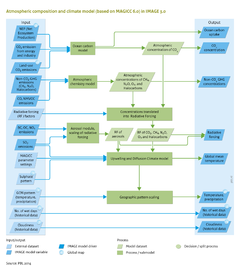Atmospheric composition and climate: Difference between revisions
Jump to navigation
Jump to search
No edit summary |
No edit summary |
||
| Line 4: | Line 4: | ||
|KeyReference=Van Vuuren and Stehfest, 2013; Meinshausen et al., 2011a; Meinshausen et al., 2011b; Müller et al., a (unpublished); Van Vuuren et al., 2011; | |KeyReference=Van Vuuren and Stehfest, 2013; Meinshausen et al., 2011a; Meinshausen et al., 2011b; Müller et al., a (unpublished); Van Vuuren et al., 2011; | ||
|Reference=IPCC, 2007a; | |Reference=IPCC, 2007a; | ||
|InputVar=Terrestrial C balance; BC, OC, NOx emissions; SO2 emission; CO, NMVOC emissions; Non CO2 GHG emissions (CH4, N2O, Halocarbon); CO2 emission from energy and industry; Terrestrial CO2 emission - grid; NEP (net ecosystem production) - grid; | |InputVar=Terrestrial C balance; BC, OC, NOx emissions; SO2 emission; CO, NMVOC emissions; Non CO2 GHG emissions (CH4, N2O, Halocarbon); CO2 emission from energy and industry; Terrestrial CO2 emission - grid; NEP (net ecosystem production) - grid; Nr of wet days - grid; Cloudiness - grid; | ||
|OutputVar=CO2 concentration; Non CO2 GHG concentrations; CO2 concentration; Radiative forcing; Global mean temperature; Temperature - grid; Precipitation - grid; Ocean carbon uptake; | |||
|OutputVar=CO2 concentration; Non CO2 GHG concentrations; CO2 concentration; Radiative forcing; Global mean temperature; Temperature - grid; Precipitation - grid; Ocean carbon uptake; | |||
|Parameter=MAGICC parameter settings; Radiative forcing factors; CGM pattern (temperature, precipitation) - grid; Sulphate pattern - grid; | |Parameter=MAGICC parameter settings; Radiative forcing factors; CGM pattern (temperature, precipitation) - grid; Sulphate pattern - grid; | ||
|Description=Climate change is generally considered among the most serious of human interferences in the environment. Emissions from fossil fuels, industry, land use and land-use change have increased greenhouse gas ([[HasAcronym::GHG]]) concentrations and caused the global mean temperature to be almost 1 oC above pre-industrial levels ([[IPCC, 2007a]]) . The impacts of climate change are already visible today and are expected to become much stronger during this century and beyond, if no action is taken and if global mean temperature could increase by 4 to 6 °C ([[IPCC, 2007a]]). Climate change impacts manifest themselves in all world regions, and practically affect all aspects of human activity. | |Description=Climate change is generally considered among the most serious of human interferences in the environment. Emissions from fossil fuels, industry, land use and land-use change have increased greenhouse gas ([[HasAcronym::GHG]]) concentrations and caused the global mean temperature to be almost 1 oC above pre-industrial levels ([[IPCC, 2007a]]) . The impacts of climate change are already visible today and are expected to become much stronger during this century and beyond, if no action is taken and if global mean temperature could increase by 4 to 6 °C ([[IPCC, 2007a]]). Climate change impacts manifest themselves in all world regions, and practically affect all aspects of human activity. | ||
Revision as of 17:19, 6 February 2014
Parts of Atmospheric composition and climate
| Component is implemented in: |
|
| Related IMAGE components |
| Projects/Applications |
| Models/Databases |
| Key publications |
| References |
Key policy issues
- What would be the impact of global climate change in this century without additional mitigation policies and measures?
- To what extent would the various scenarios to significantly reduce net greenhouse gas emissions lead to a reduction in climate change?
- To what extent does the uncertainty of geographical patterns in temperature and precipitation change influence future climate impacts and response strategies?
